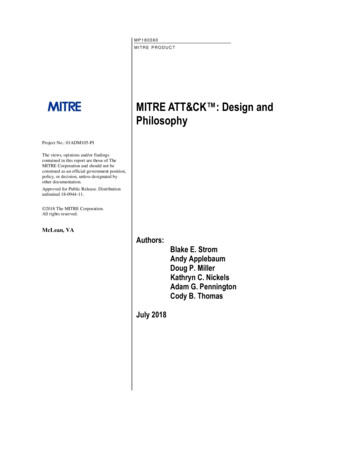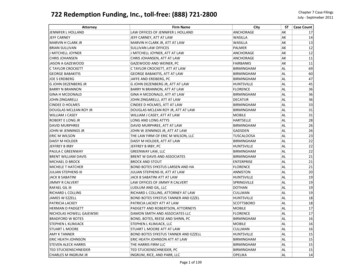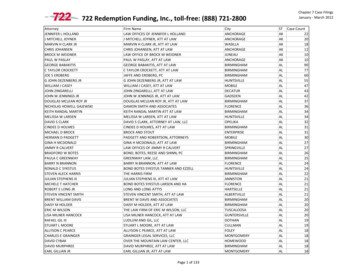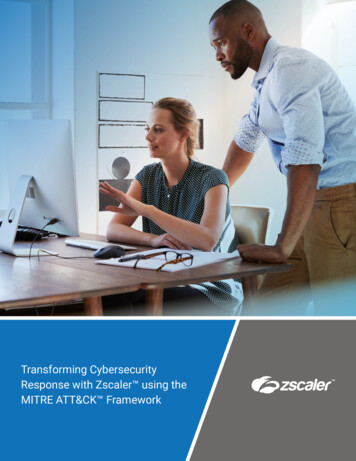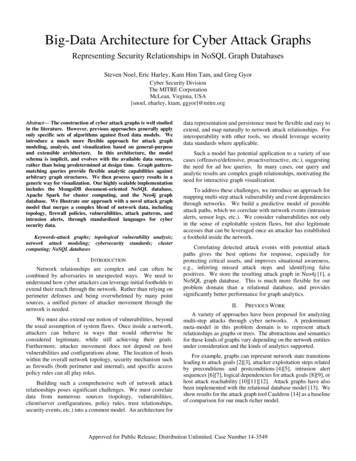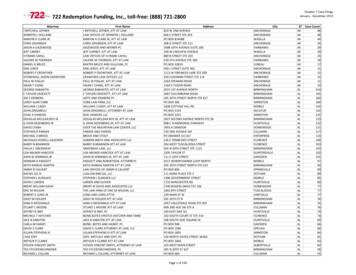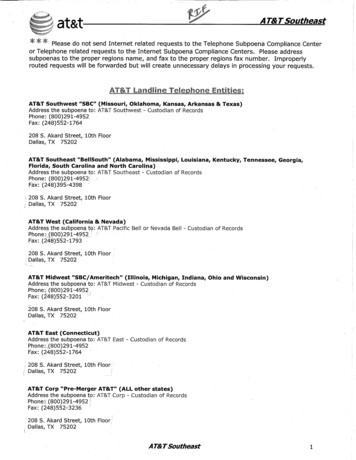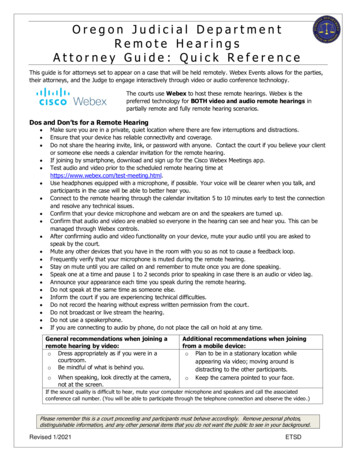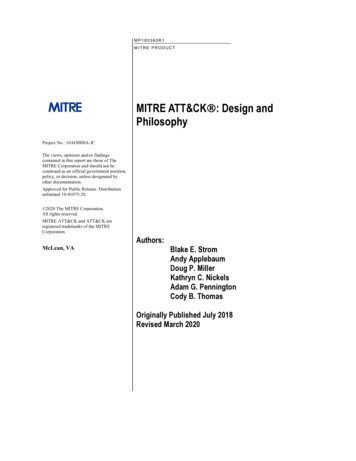
Transcription
MP180360R1MITRE PRODUCTMITRE ATT&CKÒ: Design andPhilosophyProject No.: 10AOH08A-JCThe views, opinions and/or findingscontained in this report are those of TheMITRE Corporation and should not beconstrued as an official government position,policy, or decision, unless designated byother documentation.Approved for Public Release. Distributionunlimited 19-01075-28. 2020 The MITRE Corporation.All rights reserved.MITRE ATT&CK and ATT&CK areregistered trademarks of the MITRECorporation.Authors:McLean, VABlake E. StromAndy ApplebaumDoug P. MillerKathryn C. NickelsAdam G. PenningtonCody B. ThomasOriginally Published July 2018Revised March 2020
AbstractMITRE ATT&CK is a globally-accessible knowledge base of adversary tactics and techniquesbased on real-world observations. The ATT&CK knowledge base is used as a foundation for thedevelopment of specific threat models and methodologies in the private sector, in government,and in the cybersecurity product and service community. ATT&CK provides a commontaxonomy for both offense and defense, and has become a useful conceptual tool across manycyber security disciplines to convey threat intelligence, perform testing through red teaming oradversary emulation, and improve network and system defenses against intrusions. The processMITRE used to create ATT&CK, and the philosophy that has developed for curating newcontent, are critical aspects of the work and are useful for other efforts that strive to createsimilar adversary models and information repositories.iii 2020 The MITRE Corporation. All Rights ReservedApproved for Public Release. Distribution unlimited 19-01075-28.
This page intentionally left blank.iv 2020 The MITRE Corporation. All Rights ReservedApproved for Public Release. Distribution unlimited 19-01075-28.
Executive SummaryThis paper discusses the motivation behind the creation of ATT&CK, the components describedwithin it, its design philosophy, how the project has progressed, and how it can be used. It ismeant to be used as an authoritative source of information about ATT&CK as well as a guide forhow ATT&CK is maintained and how the ATT&CK methodology is applied to createknowledge bases for new domains.v 2020 The MITRE Corporation. All Rights ReservedApproved for Public Release. Distribution unlimited 19-01075-28.
PrefaceThis paper documents the published version of ATT&CK as of March 2020 with the addition ofsub-techniques. MITRE has announced plans to evolve and expand ATT&CK throughout 2020[1]. This paper will be maintained as a living document and will be updated as significantchanges are made to ATT&CK and the process used to maintain the content within ATT&CK.vi 2020 The MITRE Corporation. All Rights ReservedApproved for Public Release. Distribution unlimited 19-01075-28.
Table of ContentsIntroduction . 11.1Background and History . 1ATT&CK Use Cases . 32.1ATT&CK Coverage . 4The ATT&CK Model. 63.1The ATT&CK Matrix. 63.2Technology Domains. 83.3Tactics. 83.4Techniques and Sub-Techniques . 93.4.1Procedures . 93.4.2Technique and Sub-Technique Object Structure . 93.4.3Sub-Technique Details . 123.5Groups . 133.5.13.6Software . 143.6.13.7Group Object Structure. 14Software Object Structure . 15Mitigations . 163.7.1Mitigation Object Structure . 163.8ATT&CK Object Model Relationships . 173.9Versioning . 193.9.1Objects . 193.9.1.1Techniques and Sub-Techniques. 193.9.1.2Groups . 193.9.1.3Software . 193.9.1.4Mitigations . 193.9.1.5Deprecation . 203.9.2Matrix . 203.9.3Releases . 20The ATT&CK Methodology . 204.1Conceptual . 204.1.1Adversary’s Perspective . 204.1.2Empirical Use . 21vii 2020 The MITRE Corporation. All Rights ReservedApproved for Public Release. Distribution unlimited 19-01075-28.
4.1.2.1Sources of Information . 214.1.2.2Community Contributions . 224.1.2.3Un(der)reported Incidents . 224.1.34.2Tactics. 244.2.14.3Abstraction . 22Impact . 24Techniques and Sub-Techniques . 254.3.1What Makes a Technique or Sub-Technique . 254.3.1.1Naming . 254.3.1.2Types of Technique Abstraction . 254.3.1.3Technical References . 264.3.1.4Adversary Use . 264.3.1.5Technique Distinction . 274.3.2Creating New Techniques . 274.3.3Enhancing Existing Techniques . 284.3.4Named Adversary Groups Using Techniques . 294.3.5Incorporation Threat Intelligence on Groups and Software within ATT&CK . 294.3.5.14.3.64.4Ungrouped Use of Techniques . 30Examples of Applying the Methodology for New Techniques . 30Applying the ATT&CK Methodology . 33Summary 34References . 35viii 2020 The MITRE Corporation. All Rights ReservedApproved for Public Release. Distribution unlimited 19-01075-28.
List of FiguresFigure 1. The ATT&CK for Enterprise Matrix . 6Figure 2. Persistence tactic with four expanded techniques . 7Figure 3. ATT&CK Model Relationships . 17Figure 4. ATT&CK Model Relationships Example . 18Figure 5. Abstraction Comparison of Models and Threat Knowledge Databases . 23ix 2020 The MITRE Corporation. All Rights ReservedApproved for Public Release. Distribution unlimited 19-01075-28.
List of TablesTable 1. ATT&CK Technology Domains . 8Table 2. ATT&CK Technique and Sub-Technique Model . 10Table 3. ATT&CK Group Model . 14Table 4. ATT&CK Software Model . 15Table 5. ATT&CK Mitigation Model . 16x 2020 The MITRE Corporation. All Rights ReservedApproved for Public Release. Distribution unlimited 19-01075-28.
This page intentionally left blank.xi 2020 The MITRE Corporation. All Rights ReservedApproved for Public Release. Distribution unlimited 19-01075-28.
IntroductionMITRE ATT&CK is a curated knowledge base and model for cyber adversary behavior,reflecting the various phases of an adversary’s attack lifecycle and the platforms they are knownto target. ATT&CK focuses on how external adversaries compromise and operate withincomputer information networks. It originated out of a project to document and categorize postcompromise adversary tactics, techniques and procedures (TTPs) against Microsoft Windowssystems to improve detection of malicious behavior. It has since grown to include Linux andmacOS, and has expanded to cover behavior leading up to the compromise of an environment, aswell as technology-focused domains like mobile devices, cloud-based systems, and industrialcontrol systems. At a high-level, ATT&CK is a behavioral model that consists of the followingcore components: Tactics, denoting short-term, tactical adversary goals during an attack; Techniques, describing the means by which adversaries achieve tactical goals; Sub-techniques, describing more specific means by which adversaries achieve tacticalgoals at a lower level than techniques; and Documented adversary usage of techniques, their procedures, and other metadata.ATT&CK is not an exhaustive enumeration of attack vectors against software. Other MITREefforts such as CAPEC [2] and CWE [3] are more applicable to this use case.1.1 Background and HistoryATT&CK was created out of a need to systematically categorize adversary behavior as part ofconducting structured adversary emulation exercises within MITRE’s FMX researchenvironment. Established in 2010, FMX provided a “living lab” capability that allowedresearchers access to a production enclave of the MITRE corporate network to deploy tools, test,and refine ideas on how to better detect threats. MITRE began researching data sources andanalytic processes within FMX for detecting advanced persistent threats (APTs) more quicklyunder an “assume breach” mentality. Cyber game exercises were conducted on a periodic basisto emulate adversaries within the heavily monitored environment and threat hunting wasperformed to test analytic hypotheses against the data collected. The goal was to improve postcompromise detection of threats penetrating enterprise networks through telemetry sensing andbehavioral analytics [4]. The primary metric for success was “How well are we doing atdetecting documented adversary behavior?” To effectively work towards that goal, it proveduseful to categorize observed behavior across relevant real-world adversary groups and use thatinformation to conduct controlled exercises emulating those adversaries within the FMXenvironment. ATT&CK was used by both the adversary emulation team (for scenariodevelopment) and the defender team (for analytic progress measurement), which made it adriving force within the FMX research.The first ATT&CK model was created in September 2013 and was primarily focused on theWindows enterprise environment. It was further refined through internal research anddevelopment and subsequently publicly released in May 2015 with 96 techniques organized1 2020 The MITRE Corporation. All Rights ReservedApproved for Public Release. Distribution unlimited 19-01075-28.
under 9 tactics. Since then, ATT&CK has experienced tremendous growth based oncontributions from the cybersecurity community. MITRE has created several additionalATT&CK-based models were created based on the methodology used to create the firstATT&CK. The original ATT&CK was expanded in 2017 beyond Windows to include Mac andLinux and has been referred to as ATT&CK for Enterprise. A complementary model called PREATT&CK was published in 2017 to focus on “left of exploit” behavior. ATT&CK for Mobilewas also published in 2017 to focus on behavior in the mobile-specific domain. ATT&CK forCloud was published in 2019 as part of Enterprise to describe behavior against cloudenvironments and services. ATT&CK for ICS was published in 2020 to document behavioragainst industrial controls systems.2 2020 The MITRE Corporation. All Rights ReservedApproved for Public Release. Distribution unlimited 19-01075-28.
ATT&CK Use CasesAdversary Emulation – The process of assessing the security of a technology domain byapplying cyber threat intelligence about specific adversaries and how they operate to emulatethat threat. Adversary emulation focuses on the ability of an organization to verify detectionand/or mitigation of the adversarial activity at all applicable points in their lifecycle.ATT&CK can be used as a tool to create adversary emulation scenarios [5] to test and verifydefenses against common adversary techniques. Profiles for specific adversary groups can beconstructed out of the information documented in ATT&CK (see Cyber Threat Intelligence usecase). These profiles can also be used by defenders and hunting teams to align and improvedefensive measures.Red Teaming – Applying an adversarial mindset without use of known threat intelligence forthe purpose of conducting an exercise. Red teaming focuses on accomplishing the end objectiveof an operation without being detected to show mission or operational impact of a successfulbreach.ATT&CK can be used as a tool to create red team plans and organize operations to avoid certaindefensive measures that may be in place within a network. It can also be used as a researchroadmap to develop new ways of performing actions that may not be detected by commondefenses.Behavioral Analytics Development – By going beyond traditional indicators of compromise(IoCs) or signatures of malicious activity, behavioral detection analytics can be used to identifypotentially malicious activity within a system or network that may not rely on prior knowledgeof adversary tools and indicators. It is a way of leveraging how an adversary interacts with aspecific platform to identify and link together suspicious activity that is agnostic or independentof specific tools that may be used.ATT&CK can be used as a tool to construct and test behavioral analytics to detect adversarialbehavior within an environment. The Cyber Analytics Repository1 (CAR) is one example ofanalytic development that could be used as a starting point for an organization to developbehavioral analytics based on ATT&CK.Defensive Gap Assessment – A defensive gap assessment allows an organization to determinewhat parts of its enterprise lack defenses and/or visibility. These gaps represent blind spots forpotential vectors that allow an adversary to gain access to its networks undetected orunmitigated.ATT&CK can be used as a common behavior-focused adversary model to assess tools,monitoring, and mitigations of existing defenses within an organization’s enterprise. Theidentified gaps are useful as a way to prioritize investments for improvement of a securityprogram. Similar security products can also be compared against a common adversary behaviormodel to determine coverage prior to purchasing.SOC Maturity Assessment – An organization’s Security Operations Center is a criticalcomponent of many medium to large enterprise networks that continuously monitor for active1https://car.mitre.org3 2020 The MITRE Corporation. All Rights ReservedApproved for Public Release. Distribution unlimited 19-01075-28.
threats against the network. Understanding the maturity of a SOC is important to determine itseffectiveness.ATT&CK can be used as one measurement to determine how effective a SOC is at detecting,analyzing, and responding to intrusions. Similar to the defensive gap assessment, a SOCMaturity assessment focuses on the processes a SOC uses to detect, understand, and respond tochanging threats to their network over time.Cyber Threat Intelligence Enrichment – Cyber threat intelligence covers knowledge of cyberthreats and threat actor groups that impact cybersecurity. It includes information about malware,tools, TTPs, tradecraft, behavior, and other indicators that are associated to threats.ATT&CK is useful for understanding and documenting adversary group profiles from abehavioral perspective that is agnostic of the tools the group may use. Analysts and defenderscan better understand common behaviors across many groups and more effectively map defensesto them and ask questions such as “what is my defensive posture against adversary groupAPT3?” Understanding how multiple groups use the same technique behavior allows analysts tofocus on impactful defenses that span may types of threats. The structured format of ATT&CKcan add value to threat reporting by categorizing behavior beyond standard indicators.Multiple groups within ATT&CK use the same techniques. For this reason, it is notrecommended to attribute activity solely based on the ATT&CK techniques used. Attribution toa group is a complex process involving all parts of the Diamond Model [5], not solely on anadversary’s use of TTPs.2.1 ATT&CK CoverageATT&CK use cases for defense and red teaming incorporate a concept of ATT&CK coverage.Whether you’re a defender looking at how many ATT&CK techniques can be detected in anenterprise, a red teamer tasked with testing ATT&CK behaviors, or a manager looking to acquirea new tool that aligns to ATT&CK, it’s important to note that in general, coverage of everyATT&CK technique is unrealistic. [7]At its core, ATT&CK documents known adversary behavior and is not intended to provide achecklist of things that need to all be addressed. Not all adversary behaviors can or should beused as a basis for alerting or providing data to an analyst. An action as simple as runningipconfig.exe to troubleshoot a network connection may happen frequently within anenvironment. This procedure falls under System Network Configuration Discovery in ATT&CKand is in the knowledge base because adversaries have been known to use it to learn about thesystem and network they’re in. With this example, the ability to collect telemetry on instances ofipconfig.exe running in an environment may be enough “coverage” as a historical activity recordthat can be referenced later. If ipconfig.exe is frequently and legitimately used then notifying ananalyst with an alert on each instance as potential intrusion behavior would be excessive.Another example is how to address use of Valid Accounts, whether they’re Local, Domain, orCloud Accounts. Use of these accounts would normally occur in any environment, but thecontext of how the accounts are used may or may not indicate the use is malicious in nature.Again, it’s important that data related to account use be collected, but it would be rare for simpleuse of the accounts to indicate an alert condition to an analyst without further context.4 2020 The MITRE Corporation. All Rights ReservedApproved for Public Release. Distribution unlimited 19-01075-28.
The techniques within ATT&CK may have many procedures for how an adversary couldimplement them — and because adversaries are always changing, it is difficult to know what allthose procedures are in advance. That makes discussing coverage of a technique tough,especially when some ways of detecting behavior rely on individual procedures and some mayspan multiple procedures or even an entire technique. Going back to the prior ipconfig.exeexample, collecting data on ipconfig.exe running may be insufficient though for coverage of theSystem Network Configuration Discovery technique because the same details can be discoveredby an adversary through other means, such as the Get-NetIPConfiguration cmdlet withinPowerShell.It is important to always review the threat intelligence on what techniques, sub-techniques, andprocedures adversaries have used to understand the details and how variations might affect howyou determine coverage. Anyone mapping to ATT&CK should be able to explain the proceduresthey cover. Similarly to how it’s unrealistic to expect coverage of 100% of ATT&CK techniques,it’s unrealistic to expect coverage of all procedures of a given technique, especially since weoften cannot know all of them in advance.Operationalizing ATT&CK for an organization also encompasses determining what it means foryou to have “ATT&CK coverage”. Is it that you’re collecting data relevant to all techniques orjust the ones that are the most important and you expect to see? Do you expect to issue alerts onall techniques or just the rarest ones? Is it important that all relevant instances of a techniquebeing seen get tagged with an ATT&CK mapping even if it may not have been performed due toa real incident? Is one, two, three, or more analytics addressing a technique sufficient to haveconfidence that a technique is covered? Does the definition of coverage expand beyond visibilityto also cover controls and preventative measures to stop techniques from being used? Does yourdefinition of coverage include conducting red team or adversary emulation tests to verifydefenses or test for coverage gaps?ATT&CK is just as much about the mindset and process of using it as much as it is theknowledge base itself. It serves as a grounded, threat-informed baseline of activity that everyoneshould know about. The process of gathering intelligence, implementing defenses based on thatintelligence, checking if those defenses work, and improving defenses to better cover threatsover time is what should be strived for, not 100% coverage of ATT&CK. When it comes toinformation security, the threats we face, new technologies, and the adaptability of goal-basedadversaries, we cannot consider filling out a checklist as “done”.5 2020 The MITRE Corporation. All Rights ReservedApproved for Public Release. Distribution unlimited 19-01075-28.
The ATT&CK ModelThe basis of ATT&CK is the set of techniques and sub-techniques that represent actions thatadversaries can perform to accomplish objectives. Those objectives are represented by the tacticcategories the techniques and sub-techniques fall under. This relatively simple representationstrikes a useful balance between sufficient technical detail at the technique level and the contextaround why actions occur at the tactic level.3.1 The ATT&CK MatrixThe relationship between tactics, techniques, and sub-techniques can be visualized in theATT&CK Matrix. For example, under the Persistence tactic (this is the adversary’s goal – topersist in the target environment), there are a series of techniques including Hijack ExecutionFlow, Pre-OS Boot, and Scheduled Task/Job. Each of these is a single technique that adversariesmay use to achieve the goal of persistence. Figure 1 depicts the ATT&CK Matrix for EnterpriseFigure 1. The ATT&CK for Enterprise MatrixFurthermore, some techniques can be broken down into sub-techniques that describe in moredetail how those behaviors can be performed. For example, Pre-OS Boot has three subtechniques consisting of Bootkit, Component Firmware, and System Firmware to describe howpersistence is achieved before an operating system boots. Figure 2 depicts the Persistence Tacticwith techniques and four techniques expanded to show sub-techniques: Account Manipulation,Pre-OS Boot, Scheduled Task/Job, and Server Software Component6 2020 The MITRE Corporation. All Rights ReservedApproved for Public Release. Distribution unlimited 19-01075-28.
Figure 2. Persistence tactic with four expanded techniques7 2020 The MITRE Corporation. All Rights ReservedApproved for Public Release. Distribution unlimited 19-01075-28.
3.2 Technology DomainsATT&CK is organized in a series of “technology domains” - the ecosystem an adversaryoperates within that provides a set of constraints the adversary must circumvent or takeadvantage of to accomplish a set of objectives. To date MITRE has defined three technologydomains – Enterprise (representing traditional enterprise networks and cloud technologies),Mobile (for mobile communication devices), and ICS (for industrial control systems). Withineach technology domain, ATT&CK defines multiple “platforms” - the system an adversary isoperating within. A platform may be an operating system or application (e.g. MicrosoftWindows). Techniques and sub-techniques can apply to multiple platforms. Table 1 lists theplatforms currently defined for ATT&CK technology domains except for ICS, which will bedocumented in a separate philosophy paper.The scope of ATT&CK also expands beyond technology domains with PRE-ATT&CK. PREATT&CK covers documentation of adversarial behavior during requirements gathering,reconnaissance, and weaponization before access to a network is obtained. It is independent oftechnology and models an adversary’s behavior as they attempt to gain access to an organizationor entity through the technology they leverage, spanning multiple domains.Table 1. ATT&CK Technology DomainsTechnology DomainEnterpriseMobilePlatform(s) definedLinux, macOS, Windows, AWS, Azure, GCP, SaaS, Office365, Azure ADAndroid, iOS3.3 TacticsTactics represent the “why” of an ATT&CK technique or sub-technique. It is the adversary’stactical objective: the reason for performing an action. Tactics serve as useful contextualcategories for individual techniques and cover standard notations for things adversaries do duringan operation, such as persist, discover information, move laterally, execute files, and exfiltratedata. Tactics are treated as “tags” within ATT&CK where a technique or sub-technique isassociated or tagged with one or more tactic categories depending on the different results thatcan be achieved by using a technique.Each tactic contains a definition describing the category and serves as a guide for whattechniques should be within the tactic. For example, Execution is defined as a tactic thatrepresents (sub-)techniques that result in execution of adversary-controlled code on a local orremote system. This tactic is often used in conjunction with initial access as the means ofexecuting code once access is obtained, and lateral movement to expand access to remotesystems on a network.Additional tactic categories may be defined as needed to more accurately describe adversaryobjectives. Applications of the ATT&CK modeling methodology for other domains may requirenew or different categories to associate techniques even though there may be some overlap withtactic definitions in existing models.8 2020 The MITRE Corporation. All Rights ReservedApproved for Public Release. Distribution unlimited 19-01075-28.
3.4 Techniques and Sub-TechniquesTechniques represent “how” an adversary achieves a tactical objective by performing an action.For example, an adversary may dump credentials from an operating system to gain access touseful credentials within a network. Techniques may also represent “what” an adversary gains byperforming an action. This is a useful distinction for the Discovery tactic a
within it, its design philosophy, how the project has progressed, and how it can be used. It is meant to be used as an authoritative source of information about ATT&CK as well as a guide for how ATT&CK is maintained and how the ATT&CK methodology is applied to create knowledge bases for new domains.
